The Cambridge History of Japan, Vol. 3: Medieval Japan
Подождите немного. Документ загружается.

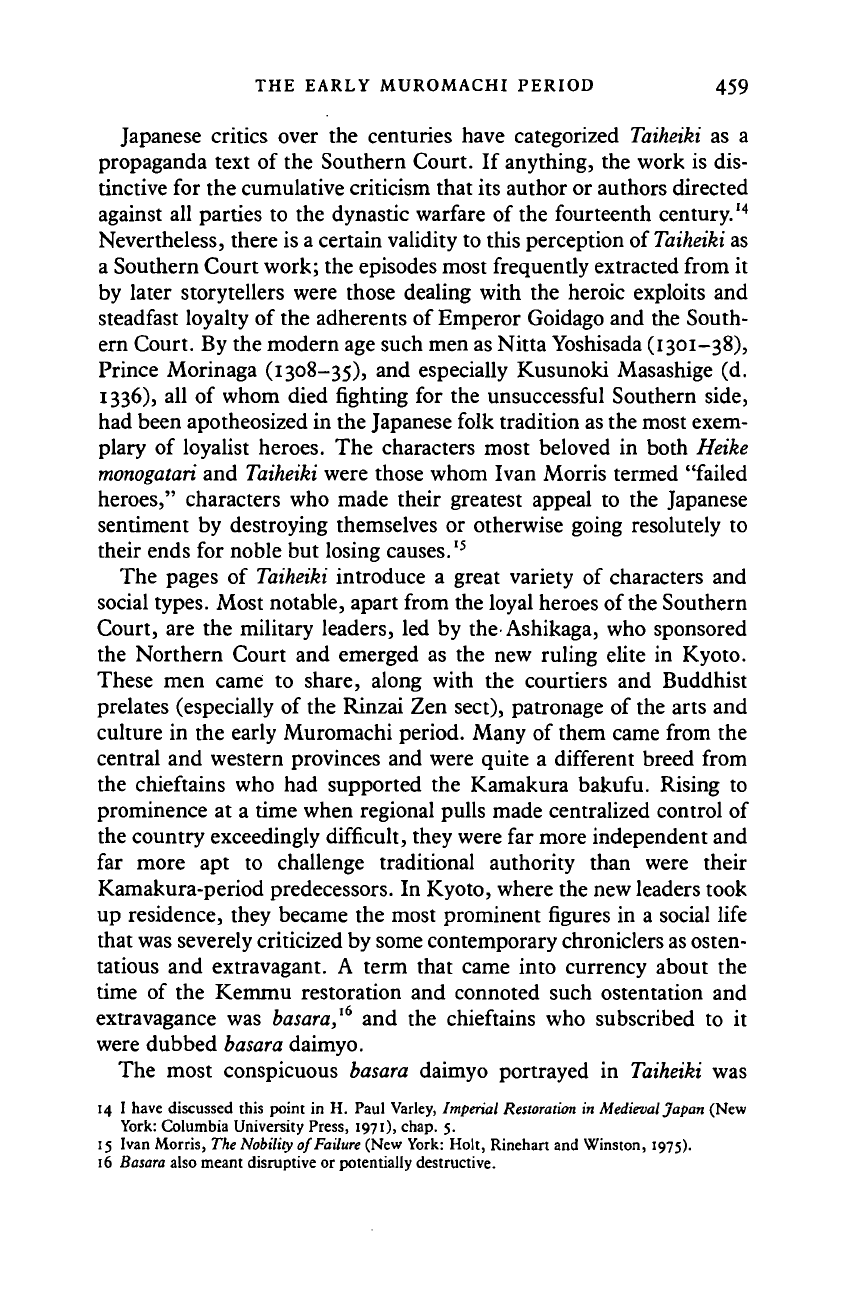
THE EARLY MUROMACHI PERIOD 459
Japanese critics over the centuries have categorized Taiheiki as a
propaganda text of the Southern Court. If anything, the work is dis-
tinctive for the cumulative criticism that its author or authors directed
against all parties to the dynastic warfare of the fourteenth century.'
4
Nevertheless, there is a certain validity to this perception of Taiheiki as
a Southern Court work; the episodes most frequently extracted from it
by later storytellers were those dealing with the heroic exploits and
steadfast loyalty of the adherents of Emperor Goidago and the South-
ern Court. By the modern age such men as Nitta Yoshisada (1301-38),
Prince Morinaga (1308-35), and especially Kusunoki Masashige (d.
1336),
all of whom died fighting for the unsuccessful Southern side,
had been apotheosized in the Japanese folk tradition as the most exem-
plary of loyalist heroes. The characters most beloved in both Heike
monogatari
and Taiheiki were those whom Ivan Morris termed "failed
heroes," characters who made their greatest appeal to the Japanese
sentiment by destroying themselves or otherwise going resolutely to
their ends for noble but losing causes.'
5
The pages of Taiheiki introduce a great variety of characters and
social types. Most notable, apart from the loyal heroes of the Southern
Court, are the military leaders, led by theAshikaga, who sponsored
the Northern Court and emerged as the new ruling elite in Kyoto.
These men came to share, along with the courtiers and Buddhist
prelates (especially of the Rinzai Zen sect), patronage of the arts and
culture in the early Muromachi period. Many of them came from the
central and western provinces and were quite a different breed from
the chieftains who had supported the Kamakura bakufu. Rising to
prominence at a time when regional pulls made centralized control of
the country exceedingly difficult, they were far more independent and
far more apt to challenge traditional authority than were their
Kamakura-period predecessors. In Kyoto, where the new leaders took
up residence, they became the most prominent figures in a social life
that was severely criticized by some contemporary chroniclers as osten-
tatious and extravagant. A term that came into currency about the
time of the Kemmu restoration and connoted such ostentation and
extravagance was basara,
16
and the chieftains who subscribed to it
were dubbed basara daimyo.
The most conspicuous basara daimyo portrayed in Taiheiki was
14 I have discussed this point in H. Paul Varley, Imperial Restoration in Medieval Japan (New
York: Columbia University Press, 1971), chap. 5.
15 Ivan Morris, The Afoftttoy of Failure (New York: Holt, Rinehart and Winston, 1975).
16 Basara also meant disruptive or potentially destructive.
Cambridge Histories Online © Cambridge University Press, 2008
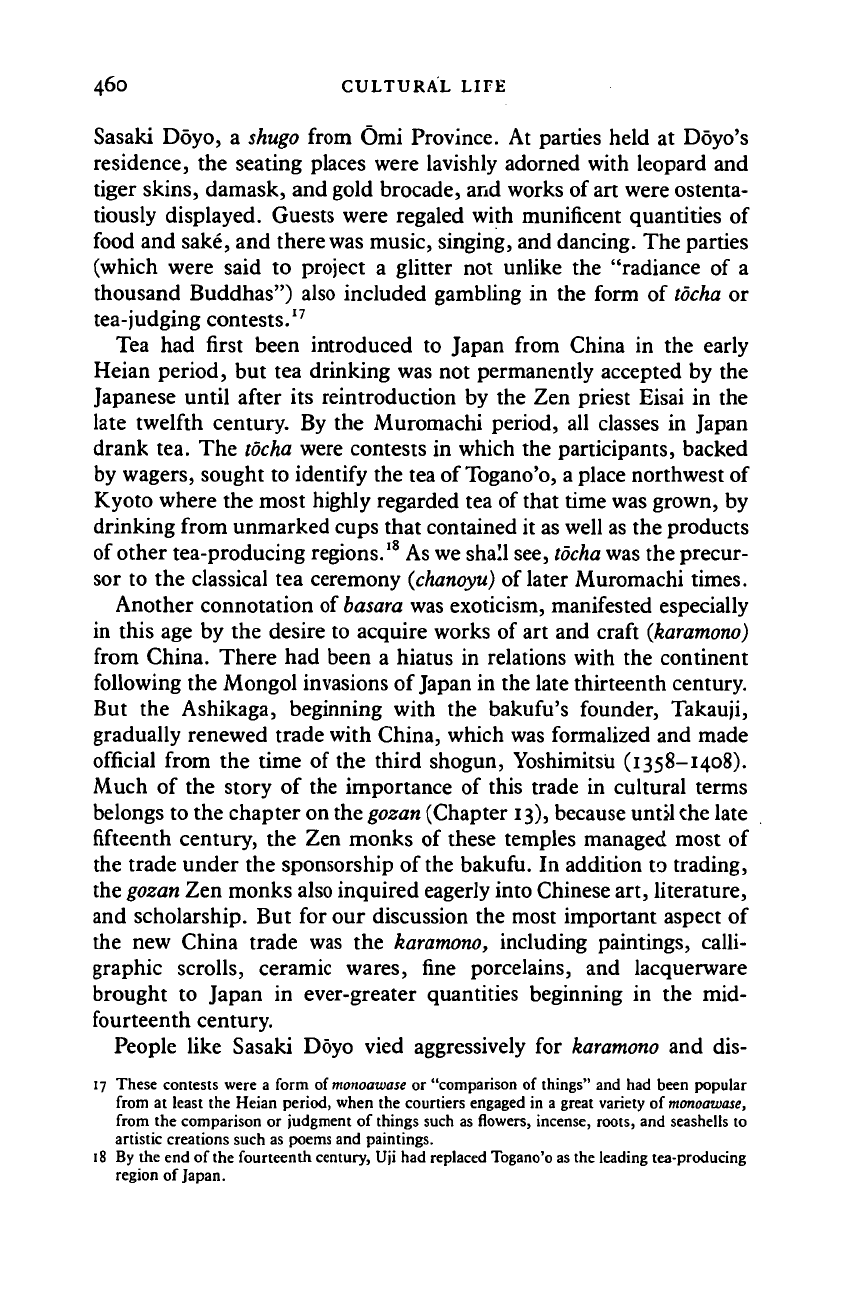
460 CULTURAL LIFE
Sasaki Doyo, a
shugo
from Omi Province. At parties held at Doyo's
residence, the seating places were lavishly adorned with leopard and
tiger skins, damask, and gold brocade, and works of art were ostenta-
tiously displayed. Guests were regaled with munificent quantities of
food and sake, and there
was
music, singing, and dancing. The parties
(which were said to project a glitter not unlike the "radiance of a
thousand Buddhas") also included gambling in the form of
tdcha
or
tea-judging contests.
17
Tea had first been introduced to Japan from China in the early
Heian period, but tea drinking was not permanently accepted by the
Japanese until after its reintroduction by the Zen priest Eisai in the
late twelfth century. By the Muromachi period, all classes in Japan
drank tea. The
tdcha
were contests in which the participants, backed
by wagers, sought to identify the tea of
Togano'o,
a place northwest of
Kyoto where the most highly regarded tea of that time was grown, by
drinking from unmarked cups that contained it as well as the products
of other tea-producing regions.
18
As we shall see,
tdcha
was the precur-
sor to the classical tea ceremony
(chanoyu)
of later Muromachi times.
Another connotation of
basara
was exoticism, manifested especially
in this age by the desire to acquire works of art and craft
{karamono)
from China. There had been a hiatus in relations with the continent
following the Mongol invasions of Japan in the late thirteenth century.
But the Ashikaga, beginning with the bakufu's founder, Takauji,
gradually renewed trade with China, which was formalized and made
official from the time of the third shogun, Yoshimitsu (1358-1408).
Much of the story of the importance of this trade in cultural terms
belongs to the chapter on the
gozan
(Chapter 13), because until the late
fifteenth century, the Zen monks of these temples managed most of
the trade under the sponsorship of
the
bakufu. In addition to trading,
the
gozan
Zen monks also inquired eagerly into Chinese art, literature,
and scholarship. But for our discussion the most important aspect of
the new China trade was the
karamono,
including paintings, calli-
graphic scrolls, ceramic wares, fine porcelains, and lacquerware
brought to Japan in ever-greater quantities beginning in the mid-
fourteenth century.
People like Sasaki Doyo vied aggressively for
karamono
and dis-
17 These contests were a form of monoawase or "comparison of things" and had been popular
from at least the Heian period, when the courtiers engaged in a great variety of monoawase,
from the comparison or judgment of things such as flowers, incense, roots, and seashells to
artistic creations such as poems and paintings.
iS By the end of the fourteenth century, Uji had replaced Togano'o as the leading tea-producing
region of Japan.
Cambridge Histories Online © Cambridge University Press, 2008
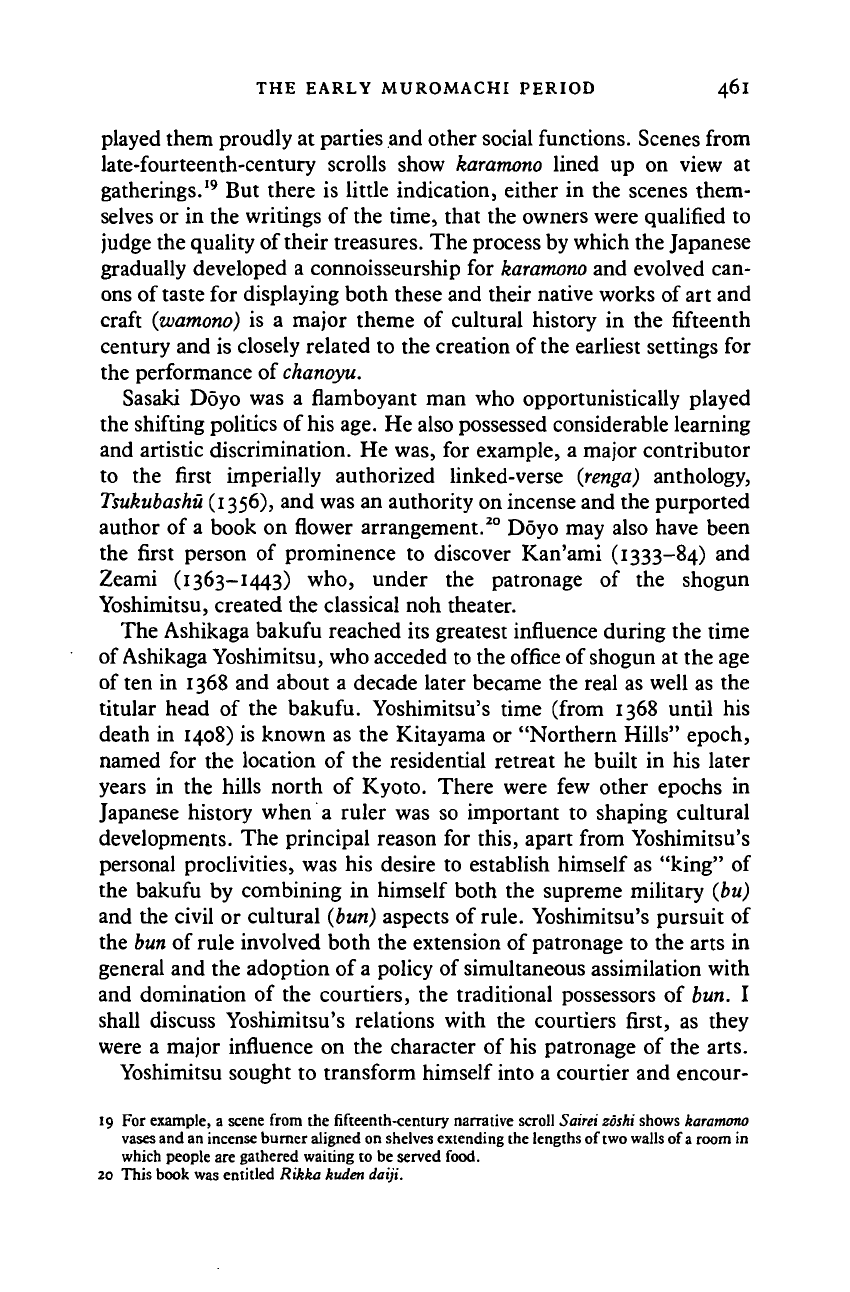
THE EARLY MUROMACHI PERIOD 461
played them proudly at parties and other social functions. Scenes from
late-fourteenth-century scrolls show karamono lined up on view at
gatherings.
19
But there is little indication, either in the scenes them-
selves or in the writings of the time, that the owners were qualified to
judge the quality of their treasures. The process by which the Japanese
gradually developed a connoisseurship for karamono and evolved can-
ons of taste for displaying both these and their native works of art and
craft (wamono) is a major theme of cultural history in the fifteenth
century and is closely related to the creation of the earliest settings for
the performance of chanoyu.
Sasaki Doyo was a flamboyant man who opportunistically played
the shifting politics of his age. He also possessed considerable learning
and artistic discrimination. He was, for example, a major contributor
to the first imperially authorized linked-verse (renga) anthology,
Tsukubashii
(1356), and was an authority on incense and the purported
author of a book on flower arrangement.
20
Doyo may also have been
the first person of prominence to discover Kan'ami (1333-84) and
Zeami (1363-1443) who, under the patronage of the shogun
Yoshimitsu, created the classical noh theater.
The Ashikaga bakufu reached its greatest influence during the time
of Ashikaga Yoshimitsu, who acceded to the office of shogun at the age
of ten in 1368 and about a decade later became the real as well as the
titular head of the bakufu. Yoshimitsu's time (from 1368 until his
death in 1408) is known as the Kitayama or "Northern Hills" epoch,
named for the location of the residential retreat he built in his later
years in the hills north of Kyoto. There were few other epochs in
Japanese history when a ruler was so important to shaping cultural
developments. The principal reason for this, apart from Yoshimitsu's
personal proclivities, was his desire to establish himself as "king" of
the bakufu by combining in himself both the supreme military (bu)
and the civil or cultural (bun) aspects of rule. Yoshimitsu's pursuit of
the bun of rule involved both the extension of patronage to the arts in
general and the adoption of a policy of simultaneous assimilation with
and domination of the courtiers, the traditional possessors of bun. I
shall discuss Yoshimitsu's relations with the courtiers first, as they
were a major influence on the character of his patronage of the arts.
Yoshimitsu sought to transform himself into a courtier and encour-
19 For example, a scene from the fifteenth-century narrative scroll Sairei zoshi shows karamono
vases and an incense burner aligned on shelves extending the lengths of two walls of
a
room in
which people are gathered waiting to be served food.
20 This book was entitled Rikka kuden daiji.
Cambridge Histories Online © Cambridge University Press, 2008
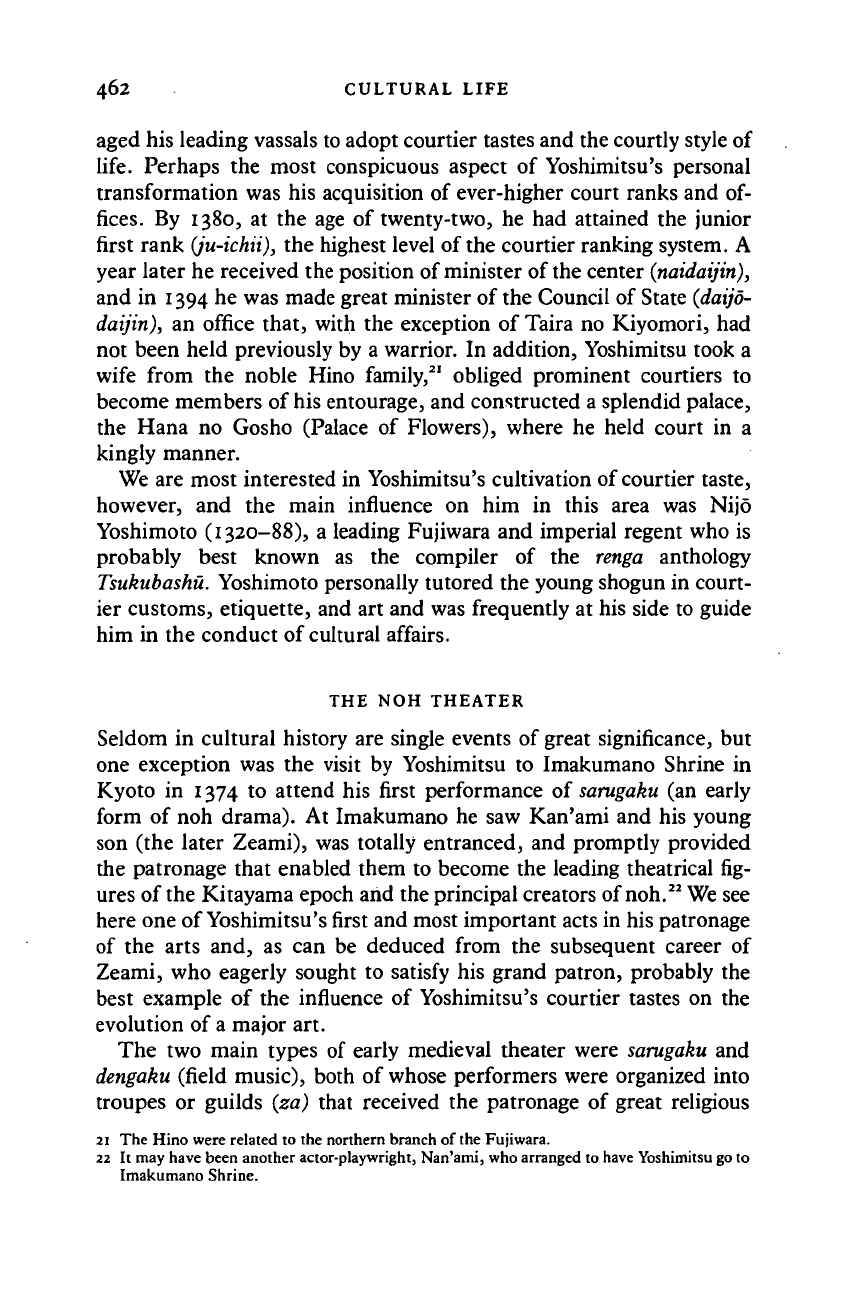
462 CULTURAL LIFE
aged his leading vassals to adopt courtier tastes and the courtly style of
life.
Perhaps the most conspicuous aspect of Yoshimitsu's personal
transformation was his acquisition of ever-higher court ranks and of-
fices. By 1380, at the age of twenty-two, he had attained the junior
first rank (ju-ichii), the highest level of the courtier ranking system. A
year later he received the position of minister of the center (naidaijin),
and in 1394 he was made great minister of the Council of State (daijo-
daijin),
an office that, with the exception of Taira no Kiyomori, had
not been held previously by a warrior. In addition, Yoshimitsu took a
wife from the noble Hino family,
21
obliged prominent courtiers to
become members of his entourage, and constructed a splendid palace,
the Hana no Gosho (Palace of Flowers), where he held court in a
kingly manner.
We are most interested in Yoshimitsu's cultivation of courtier taste,
however, and the main influence on him in this area was Nijo
Yoshimoto (1320—88), a leading Fujiwara and imperial regent who is
probably best known as the compiler of the renga anthology
Tsukubashu. Yoshimoto personally tutored the young shogun in court-
ier customs, etiquette, and art and was frequently at his side to guide
him in the conduct of cultural affairs.
THE NOH THEATER
Seldom in cultural history are single events of great significance, but
one exception was the visit by Yoshimitsu to Imakumano Shrine in
Kyoto in 1374 to attend his first performance of sarugaku (an early
form of noh drama). At Imakumano he saw Kan'ami and his young
son (the later Zeami), was totally entranced, and promptly provided
the patronage that enabled them to become the leading theatrical fig-
ures of the Kitayama epoch and the principal creators of noh.
22
We see
here one of Yoshimitsu's first and most important acts in his patronage
of the arts and, as can be deduced from the subsequent career of
Zeami, who eagerly sought to satisfy his grand patron, probably the
best example of the influence of Yoshimitsu's courtier tastes on the
evolution of a major art.
The two main types of early medieval theater were sarugaku and
dengaku (field music), both of whose performers were organized into
troupes or guilds (za) that received the patronage of great religious
21 The Hino were related to the northern branch of the Fujiwara.
22 It may have been another actor-playwright, Nan'ami, who arranged to have Yoshimitsu go to
Imakumano Shrine.
Cambridge Histories Online © Cambridge University Press, 2008
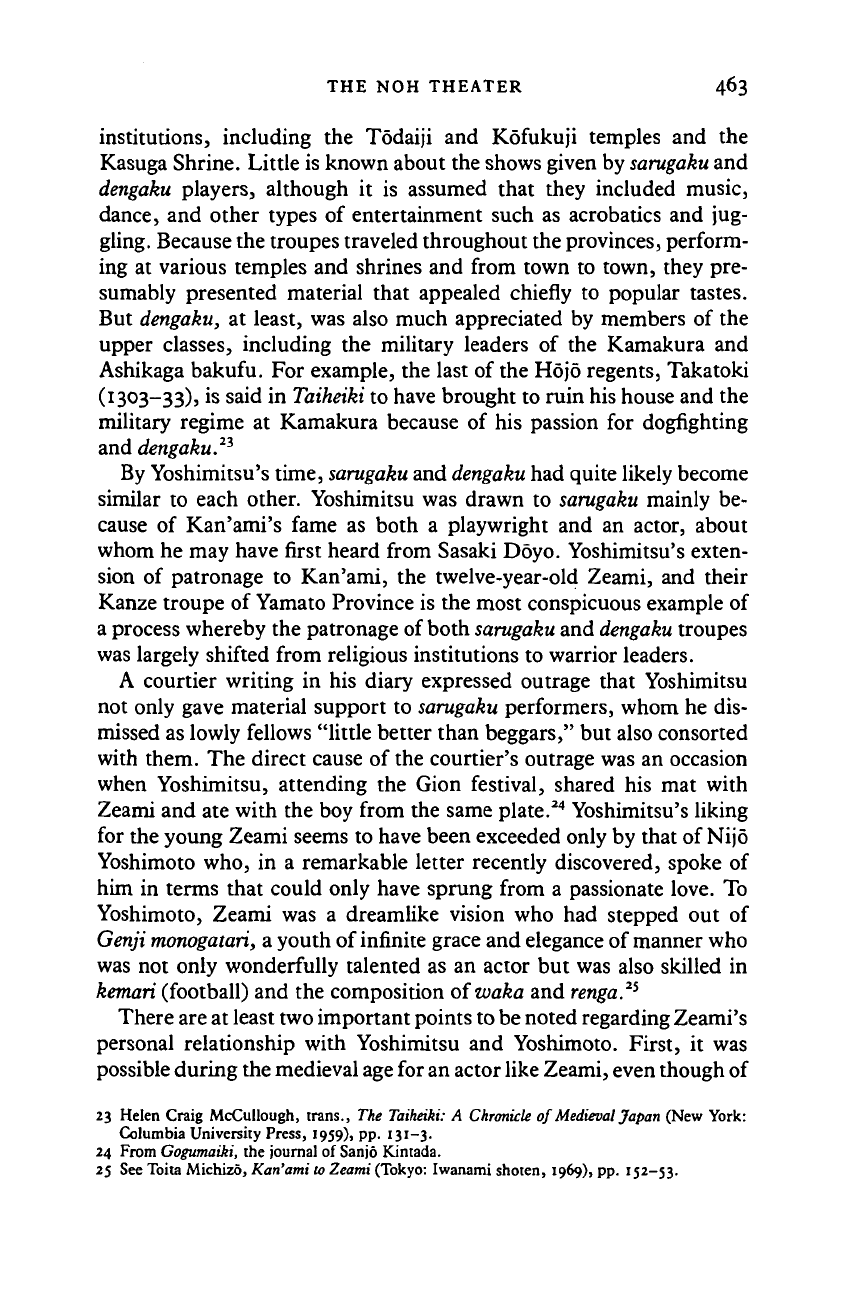
THE NOH THEATER 463
institutions, including the Todaiji and Kofukuji temples and the
Kasuga Shrine. Little is known about the shows given by
sarugaku
and
dengaku players, although it is assumed that they included music,
dance, and other types of entertainment such as acrobatics and jug-
gling. Because the troupes traveled throughout the provinces, perform-
ing at various temples and shrines and from town to town, they pre-
sumably presented material that appealed chiefly to popular tastes.
But dengaku, at least, was also much appreciated by members of the
upper classes, including the military leaders of the Kamakura and
Ashikaga bakufu. For example, the last of the Hojo regents, Takatoki
(1303-33), is said in Taiheiki to have brought to ruin his house and the
military regime at Kamakura because of his passion for dogfighting
and dengaku.
21
By Yoshimitsu's time, sarugaku and dengaku had quite likely become
similar to each other. Yoshimitsu was drawn to sarugaku mainly be-
cause of Kan'ami's fame as both a playwright and an actor, about
whom he may have first heard from Sasaki Doyo. Yoshimitsu's exten-
sion of patronage to Kan'ami, the twelve-year-old Zeami, and their
Kanze troupe of Yamato Province is the most conspicuous example of
a process whereby the patronage of both sarugaku and dengaku troupes
was largely shifted from religious institutions to warrior leaders.
A courtier writing in his diary expressed outrage that Yoshimitsu
not only gave material support to sarugaku performers, whom he dis-
missed as lowly fellows "little better than beggars," but also consorted
with them. The direct cause of the courtier's outrage was an occasion
when Yoshimitsu, attending the Gion festival, shared his mat with
Zeami and ate with the boy from the same plate.
24
Yoshimitsu's liking
for the young Zeami seems to have been exceeded only by that of Nijo
Yoshimoto who, in a remarkable letter recently discovered, spoke of
him in terms that could only have sprung from a passionate love. To
Yoshimoto, Zeami was a dreamlike vision who had stepped out of
Genji
monogatari,
a youth of infinite grace and elegance of manner who
was not only wonderfully talented as an actor but was also skilled in
kemari (football) and the composition oiwaka and renga.
25
There are at least two important points to be noted regarding Zeami's
personal relationship with Yoshimitsu and Yoshimoto. First, it was
possible during the medieval age for an actor like Zeami, even though of
23 Helen Craig McCullough, trans., The Taikeiki: A Chronicle of Medieval Japan (New York:
Columbia University Press, 1959), pp.
131—3.
24 From Gogumaiki, the journal of Sanjo Kintada.
25 See Toita Michizo, Kan'ami
to
Zeami (Tokyo: Iwanami shoten, 1969), pp. 152-53.
Cambridge Histories Online © Cambridge University Press, 2008
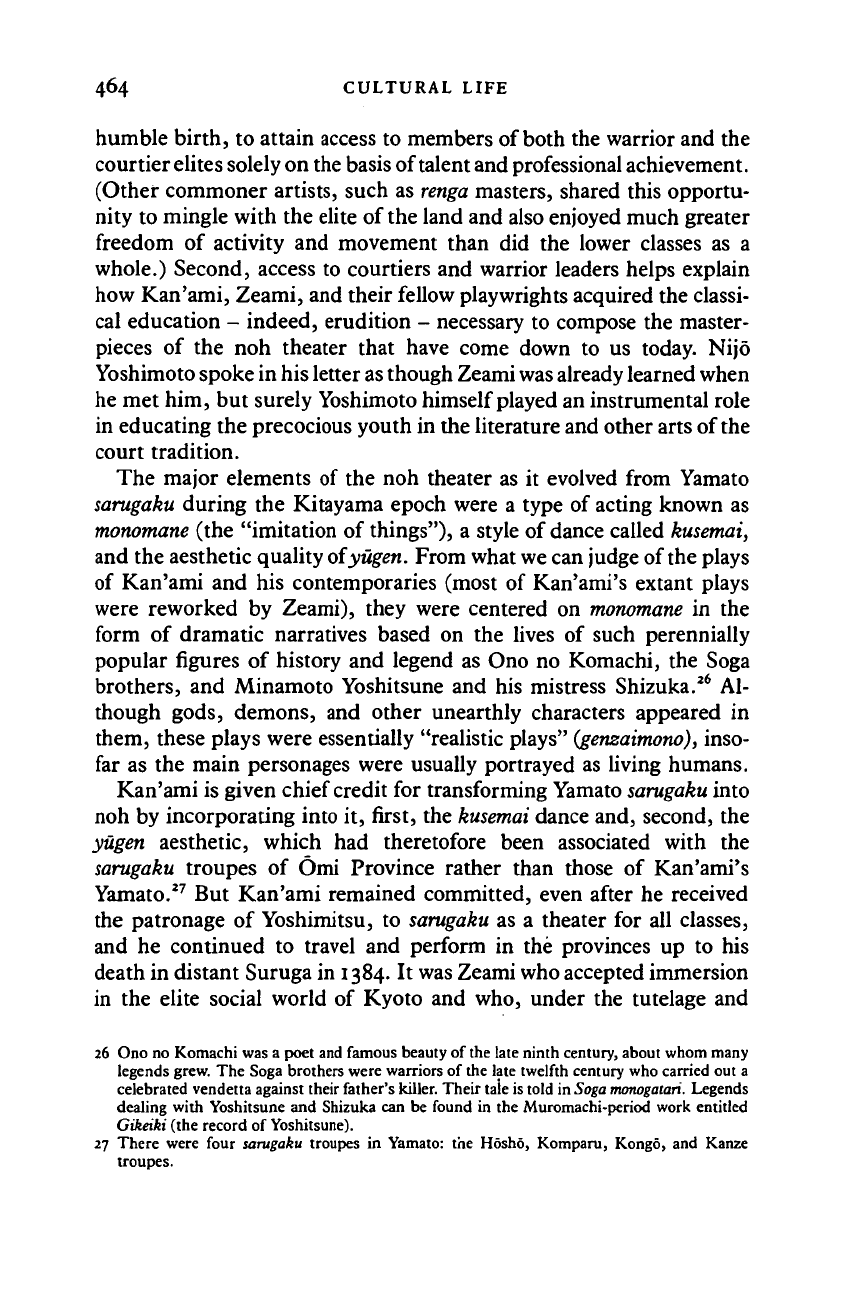
464 CULTURAL LIFE
humble birth, to attain access to members of both the warrior and the
courtier
elites
solely on the basis of talent and professional achievement.
(Other commoner artists, such as
renga
masters, shared this opportu-
nity to mingle with the elite of the land and also enjoyed much greater
freedom of activity and movement than did the lower classes as a
whole.) Second, access to courtiers and warrior leaders helps explain
how Kan'ami, Zeami, and their fellow playwrights acquired the classi-
cal education - indeed, erudition - necessary to compose the master-
pieces of the noh theater that have come down to us today. Nijo
Yoshimoto spoke in his letter
as
though
Zeami was
already learned when
he met him, but surely Yoshimoto himself played an instrumental role
in educating the precocious youth in the literature and other arts of the
court tradition.
The major elements of the noh theater as it evolved from Yamato
sarugaku
during the Kitayama epoch were a type of acting known as
monomane
(the "imitation of things"), a style of dance called
kusemai,
and the aesthetic quality of yugen. From what
we
can judge of the plays
of Kan'ami and his contemporaries (most of Kan'ami's extant plays
were reworked by Zeami), they were centered on
monomane
in the
form of dramatic narratives based on the lives of such perennially
popular figures of history and legend as Ono no Komachi, the Soga
brothers, and Minamoto Yoshitsune and his mistress Shizuka.
26
Al-
though gods, demons, and other unearthly characters appeared in
them, these plays were essentially "realistic plays"
(genzaimono),
inso-
far as the main personages were usually portrayed as living humans.
Kan'ami is given chief credit for transforming Yamato
sarugaku
into
noh by incorporating into it, first, the
kusemai
dance and, second, the
yugen aesthetic, which had theretofore been associated with the
sarugaku
troupes of Omi Province rather than those of Kan'ami's
Yamato.
27
But Kan'ami remained committed, even after he received
the patronage of Yoshimitsu, to
sarugaku
as a theater for all classes,
and he continued to travel and perform in the provinces up to his
death in distant Suruga in 1384. It was Zeami who accepted immersion
in the elite social world of Kyoto and who, under the tutelage and
26 Ono no Komachi was a poet and famous beauty of the late ninth century, about whom many
legends grew. The Soga brothers were warriors of the late twelfth century who carried out a
celebrated vendetta against their father's killer. Their tale is told in Soga
monogatari.
Legends
dealing with Yoshitsune and Shizuka can be found in the Muromachi-period work entitled
Gikeiki (the record of Yoshitsune).
27 There were four sarugaku troupes in Yamato: the Hosho, Komparu, Kongo, and Kanze
troupes.
Cambridge Histories Online © Cambridge University Press, 2008
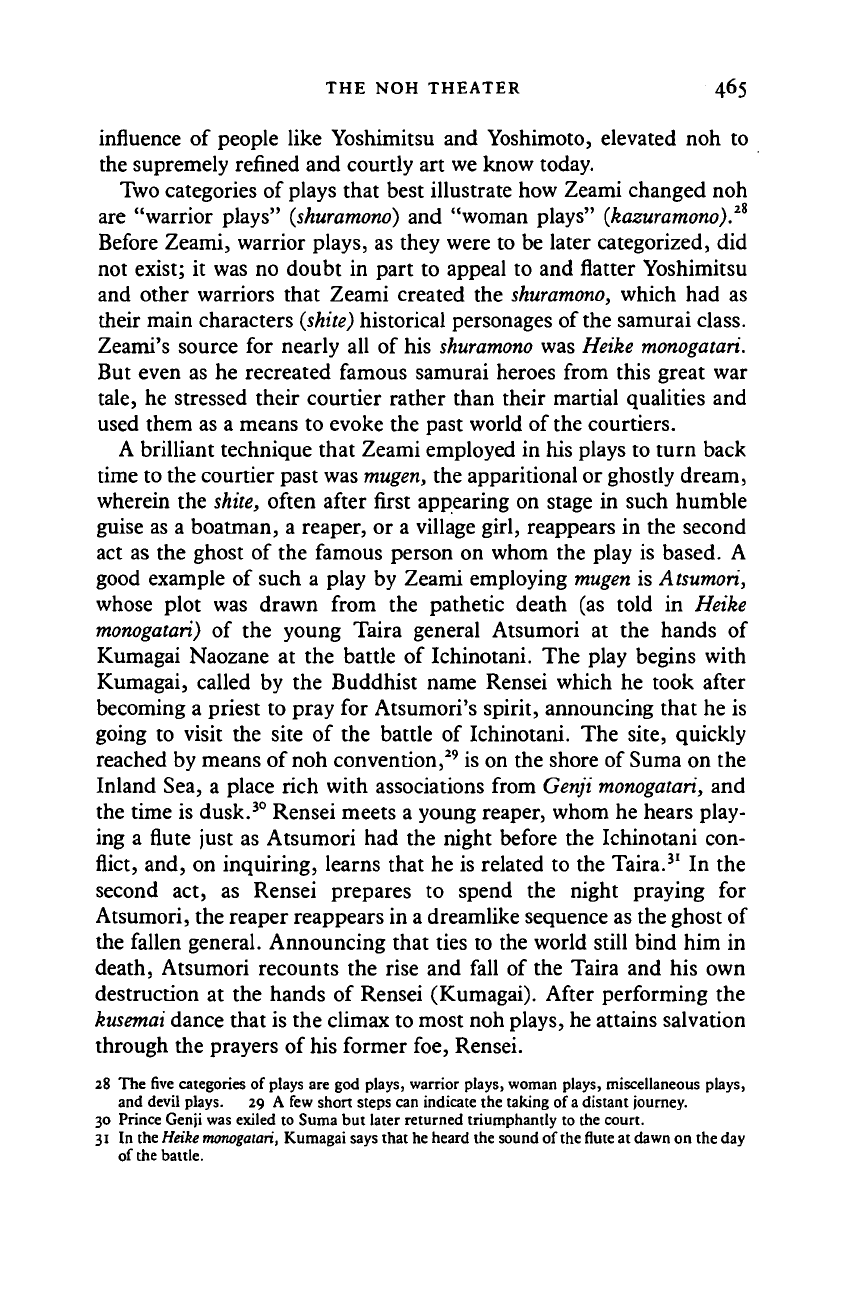
THE NOH THEATER 465
influence of people like Yoshimitsu and Yoshimoto, elevated noh to
the supremely refined and courtly art we know today.
Two categories of plays that best illustrate how Zeami changed noh
are "warrior plays" (shuramono) and "woman plays" (kazuramono).
2
*
Before Zeami, warrior plays, as they were to be later categorized, did
not exist; it was no doubt in part to appeal to and flatter Yoshimitsu
and other warriors that Zeami created the shuramono, which had as
their main characters (shite) historical personages of the samurai class.
Zeami's source for nearly all of his
shuramono
was Heike monogatari.
But even as he recreated famous samurai heroes from this great war
tale,
he stressed their courtier rather than their martial qualities and
used them as a means to evoke the past world of the courtiers.
A brilliant technique that Zeami employed in his plays to turn back
time to the courtier past was mugen, the apparitional or ghostly dream,
wherein the shite, often after first appearing on stage in such humble
guise as a boatman, a reaper, or a village girl, reappears in the second
act as the ghost of the famous person on whom the play is based. A
good example of such a play by Zeami employing mugen is Atsumori,
whose plot was drawn from the pathetic death (as told in Heike
monogatari) of the young Taira general Atsumori at the hands of
Kumagai Naozane at the battle of Ichinotani. The play begins with
Kumagai, called by the Buddhist name Rensei which he took after
becoming a priest to pray for Atsumori's spirit, announcing that he is
going to visit the site of the battle of Ichinotani. The site, quickly
reached by means of noh convention,
29
is on the shore of Suma on the
Inland Sea, a place rich with associations from Genji monogatari, and
the time is dusk.
30
Rensei meets a young reaper, whom he hears play-
ing a flute just as Atsumori had the night before the Ichinotani con-
flict, and, on inquiring, learns that he is related to the Taira.
31
In the
second act, as Rensei prepares to spend the night praying for
Atsumori, the reaper reappears in a dreamlike sequence as the ghost of
the fallen general. Announcing that ties to the world still bind him in
death, Atsumori recounts the rise and fall of the Taira and his own
destruction at the hands of Rensei (Kumagai). After performing the
kusemai dance that is the climax to most noh plays, he attains salvation
through the prayers of his former foe, Rensei.
28 The five categories of plays are god plays, warrior plays, woman plays, miscellaneous plays,
and devil plays. 29 A few short steps can indicate the taking of
a
distant journey.
30 Prince Genji was exiled to Suma but later returned triumphantly to the court.
31 In the
Heike
monogatari,
Kumagai says that he heard the sound of
the
flute at dawn on the day
of the battle.
Cambridge Histories Online © Cambridge University Press, 2008
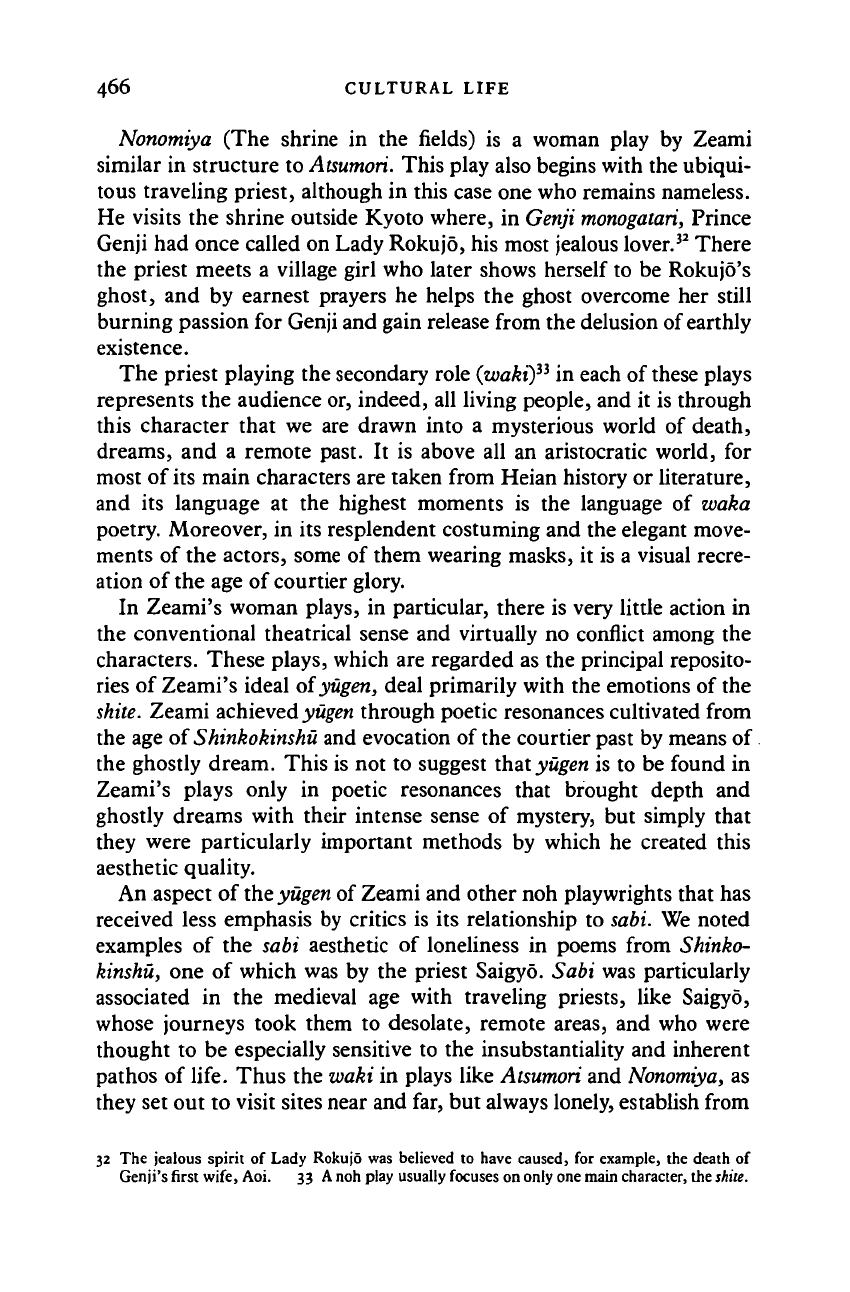
466 CULTURAL LIFE
Nonomiya (The shrine in the fields) is a woman play by Zeami
similar in structure to
Atsumori.
This play also begins with the ubiqui-
tous traveling priest, although in this case one who remains nameless.
He visits the shrine outside Kyoto where, in
Genji
monogatari,
Prince
Genji had once called on Lady Rokujo, his most jealous lover.
32
There
the priest meets a village girl who later shows herself to be Rokujo's
ghost, and by earnest prayers he helps the ghost overcome her still
burning passion for Genji and gain release from the delusion of earthly
existence.
The priest playing the secondary role (waki)
Si
in each of these plays
represents the audience or, indeed, all living people, and it is through
this character that we are drawn into a mysterious world of death,
dreams, and a remote past. It is above all an aristocratic world, for
most of its main characters are taken from Heian history or literature,
and its language at the highest moments is the language of waka
poetry. Moreover, in its resplendent costuming and the elegant move-
ments of the actors, some of them wearing masks, it is a visual recre-
ation of the age of courtier glory.
In Zeami's woman plays, in particular, there is very little action in
the conventional theatrical sense and virtually no conflict among the
characters. These plays, which are regarded as the principal reposito-
ries of Zeami's ideal oi
yugen,
deal primarily with the emotions of the
shite.
Zeami achieved
yugen
through poetic resonances cultivated from
the age of
Shinkokinshu
and evocation of the courtier past by means of
the ghostly dream. This is not to suggest that
yiigen
is to be found in
Zeami's plays only in poetic resonances that brought depth and
ghostly dreams with their intense sense of mystery, but simply that
they were particularly important methods by which he created this
aesthetic quality.
An aspect of
the yugen
of Zeami and other noh playwrights that has
received less emphasis by critics is its relationship to
sabi.
We noted
examples of the sabi aesthetic of loneliness in poems from Shinko-
kinshu, one of which was by the priest Saigyo. Sabi was particularly
associated in the medieval age with traveling priests, like Saigyo,
whose journeys took them to desolate, remote areas, and who were
thought to be especially sensitive to the insubstantiality and inherent
pathos of life. Thus the waki in plays like
Atsumori
and
Nonomiya,
as
they set out to visit sites near and far, but always lonely, establish from
32 The jealous spirit of Lady Rokujo was believed to have caused, for example, the death of
Genji's first wife, Aoi. 33
A
noh play usually focuses on only one main character, the shite.
Cambridge Histories Online © Cambridge University Press, 2008
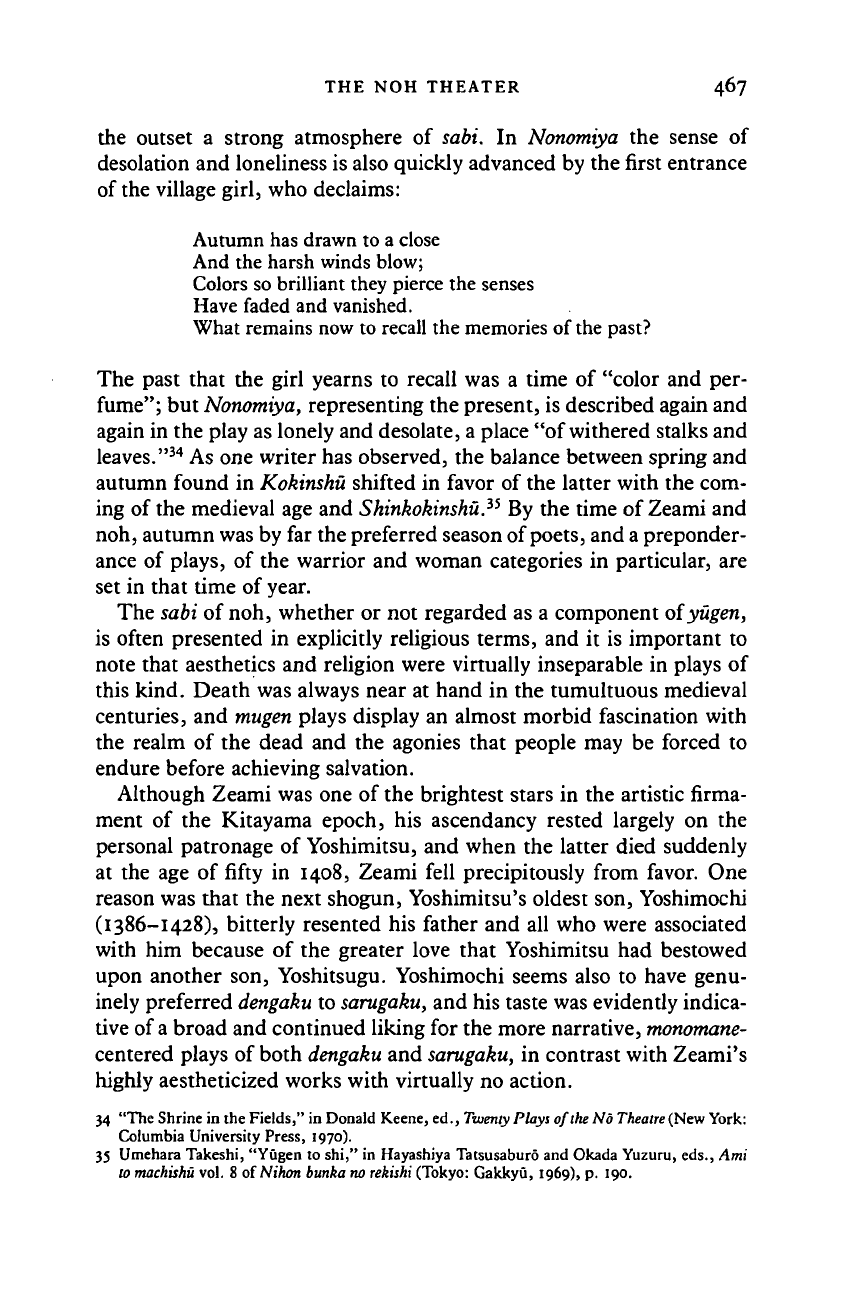
THE NOH THEATER 467
the outset a strong atmosphere of sabi. In Nonomiya the sense of
desolation and loneliness is also quickly advanced by the first entrance
of the village girl, who declaims:
Autumn has drawn to a close
And the harsh winds blow;
Colors so brilliant they pierce the senses
Have faded and vanished.
What remains now to recall the memories of the past?
The past that the girl yearns to recall was a time of "color and per-
fume"; but Nonomiya, representing the present, is described again and
again in the play as lonely and desolate, a place "of withered stalks and
leaves."
34
As one writer has observed, the balance between spring and
autumn found in Kokinshu shifted in favor of the latter with the com-
ing of the medieval age and Shinkokinshu.
35
By the time of Zeami and
noh, autumn was by far the preferred season of
poets,
and a preponder-
ance of plays, of the warrior and woman categories in particular, are
set in that time of year.
The sabi of noh, whether or not regarded as a component ofyugen,
is often presented in explicitly religious terms, and it is important to
note that aesthetics and religion were virtually inseparable in plays of
this kind. Death was always near at hand in the tumultuous medieval
centuries, and mugen plays display an almost morbid fascination with
the realm of the dead and the agonies that people may be forced to
endure before achieving salvation.
Although Zeami was one of the brightest stars in the artistic firma-
ment of the Kitayama epoch, his ascendancy rested largely on the
personal patronage of Yoshimitsu, and when the latter died suddenly
at the age of fifty in 1408, Zeami fell precipitously from favor. One
reason was that the next shogun, Yoshimitsu's oldest son, Yoshimochi
(1386-1428), bitterly resented his father and all who were associated
with him because of the greater love that Yoshimitsu had bestowed
upon another son, Yoshitsugu. Yoshimochi seems also to have genu-
inely preferred dengaku to sarugaku, and his taste was evidently indica-
tive of
a
broad and continued liking for the more narrative, monomane-
centered plays of both dengaku and sarugaku, in contrast with Zeami's
highly aestheticized works with virtually no action.
34 "The Shrine in the Fields," in Donald Keene, ed.,
Twenty
Plays of
the
No
Theatre
(New York:
Columbia University Press, 1970).
35 Umehara Takeshi, "Yugen to shi," in Hayashiya Tatsusaburd and Okada Yuzuru, eds., Ami
to
machishu
vol. 8 oiNihon bunka no
rekishi
(Tokyo: Gakkyu, 1969), p. 190.
Cambridge Histories Online © Cambridge University Press, 2008
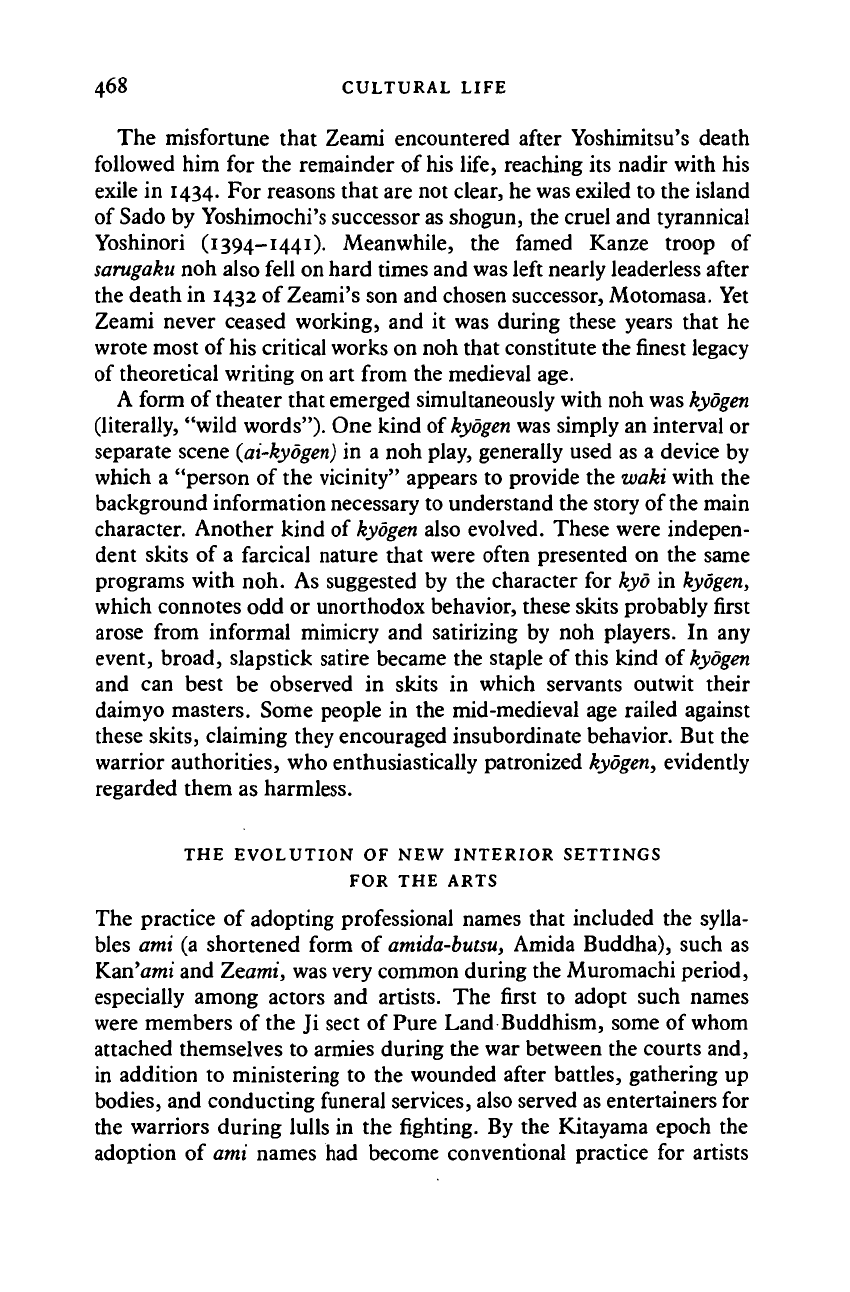
468 CULTURAL LIFE
The misfortune that Zeami encountered after Yoshimitsu's death
followed him for the remainder of his life, reaching its nadir with his
exile in 1434. For reasons that are not clear, he was exiled to the island
of Sado by Yoshimochi's successor as shogun, the cruel and tyrannical
Yoshinori (1394-1441). Meanwhile, the famed Kanze troop of
sanigaku
noh also fell on hard times and was left nearly leaderless after
the death in 1432 of Zeami's son and chosen successor, Motomasa. Yet
Zeami never ceased working, and it was during these years that he
wrote most of
his
critical works on noh that constitute the finest legacy
of theoretical writing on art from the medieval age.
A form of theater that emerged simultaneously with noh was
kyogen
(literally, "wild words"). One kind of
kyogen
was simply an interval or
separate scene
(ai-kyogen)
in a noh play, generally used as a device by
which a "person of the vicinity" appears to provide the waki with the
background information necessary to understand the story of the main
character. Another kind of
kyogen
also evolved. These were indepen-
dent skits of a farcical nature that were often presented on the same
programs with noh. As suggested by the character for kyo in
kyogen,
which connotes odd or unorthodox behavior, these skits probably first
arose from informal mimicry and satirizing by noh players. In any
event, broad, slapstick satire became the staple of this kind of
kyogen
and can best be observed in skits in which servants outwit their
daimyo masters. Some people in the mid-medieval age railed against
these skits, claiming they encouraged insubordinate behavior. But the
warrior authorities, who enthusiastically patronized
kyogen,
evidently
regarded them as harmless.
THE EVOLUTION OF NEW INTERIOR SETTINGS
FOR THE ARTS
The practice of adopting professional names that included the sylla-
bles ami (a shortened form of
amida-butsu,
Amida Buddha), such as
Kan
1
ami and Zeami, was very common during the Muromachi period,
especially among actors and artists. The first to adopt such names
were members of the Ji sect of Pure Land Buddhism, some of whom
attached themselves to armies during the war between the courts and,
in addition to ministering to the wounded after battles, gathering up
bodies, and conducting funeral services, also served as entertainers for
the warriors during lulls in the fighting. By the Kitayama epoch the
adoption of ami names had become conventional practice for artists
Cambridge Histories Online © Cambridge University Press, 2008
